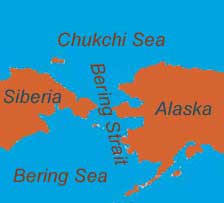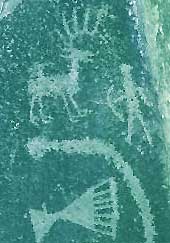STEP
INTO THE GED
HISTORY
READING: Early Humans in North America
IN THIS UNIT:
Reading Passage and Practice: Early America
Math: Calculate dates and periods of time.
Vocabulary: Practice geographical terms.
Writing: Express opinions, summarize, correct sentences with errors, find main ideas.
Project: Create a table with dates and events.
Game: Early America crossword puzzle.
SUPPORT ACTIVITIES IN
READING | WRITING | MATH | PROJECT | FUN
Click on the words
highlighted in yellow
to get a definition.
When you finish the reading, go to other support activities.
The first humans to cross into America walked over an ice bridge. That bridge temporarily joined two land masses and let people cross over from Asia to America.
The Ice Age was a period which reached its peak between 34,000 and 30,000 BC. During that time, huge continental ice sheets held much of the world's water. A frozen land bridge arose between Asia and North America. It was called Beringia. Beringia joined Alaska, in North America, and Siberia, in Asia. Ancient people from Asia crossed this bridge and came to America. Beringia disappeared under water about 10 thousand years ago when the glaciers began to melt. It was replaced by what is now the Bering Strait.
Beringia was probably some 1,500 kilometers wide. It had grasses and plant life that attracted large animals, such as the mammoth. These animals were hunted by early humans. They followed their game across the land bridge. These hunters were the first people to cross into the new continent, now known as North America.
Early humans crossed down through Alaska. They traveled south to what is now the United States and even South America. Evidence of that early life continues to be found.As the mammoth began to die out, the bison took its place as a principal source of food. Their hides were also useful to early North Americans. Over time, more and more species of large game died out. Plants, berries and seeds took their place and became important in the early American diet. Early Indians introduced a primitive form of agriculture in what is now central Mexico. They grew corn, squash and beans, perhaps as early as 8,000 B.C.
By 3,000 B.C., a primitive type of corn was being grown in the river valleys of New Mexico and Arizona. That's where the first signs of irrigation began to appear. By 300 B.C., we can find signs of early village life .
By the first centuries A.D., the Hohokum people occupied a wide area of south-central Arizona roughly around Flagstaff. They migrated south to the Mexican border. They became the most skillful irrigation farmers the Southwest ever knew.



Brain Gym

What common phrase does the image below represent?

![]()
![]()